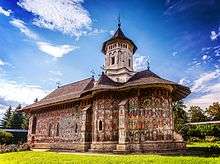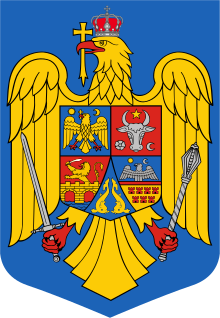Romanian architecture
Romanian architecture is diverse, including medieval architecture, modern era architecture, interwar architecture, communist architecture, and contemporary 21st century architecture. In Romania, there are also regional differences with regard to architectural styles.
| Part of a series on the |
| Culture of Romania |
|---|
 |
| History |
| People |
| Languages |
|
Mythology and folklore
|
|
Festivals |
|
|
|
Music and performing arts
|
|
Media |
| Sport |
|
Organisations |
|
Pre-Modern styles
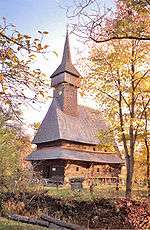
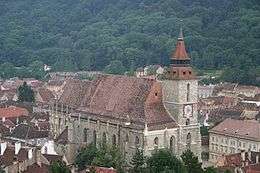
During the middle ages in Romania there were two types of construction that developed in parallel and different in point of both materials and technique. The first is the popular architecture, whose most spectacular achievements were the wooden churches, especially those in the villages of Maramureş, Banat and Apuseni Mountains, where the tradition is still carried out today. In Maramureş, in Surdeşti village, the 54 m high church tower built during 1721–1724 is among the highest of this kind in Europe. The second consists mainly of monasteries, as well as princely seats or boyar mansions. Most of the old lay edifices were destroyed by time, wars, earthquakes and fires.
In mediaeval architecture, influences of Western trends can be traced, to a greater or lesser extent, in all the three lands inhabited by Romanians. Such influences are stronger in Transylvania, and weaker in Moldavia, in forms absorbed by local and Byzantine tradition. In Wallachia, Western elements in architecture were even fewer; there, from the 14th-century architecture was based on the local adaptation of the Byzantine model (the Princely Church in Curtea de Arges and the Cozia Monastery).
There are monuments significant for the Transylvanian Gothic style preserved to this day, in spite of all alterations, such as the Black Church in Braşov (14th and 15th centuries) and a number of other cathedrals, as well as the Bran Castle in Braşov County (14th century), the Hunyad Castle in Hunedoara (15th century).
Transylvania also developed fortified towns extensively during the Middle Ages; their urban growth respected principles of functionality (the usual pattern is a central market place with a church, narrow streets with sides linked here and there by archways): the cities of Sighişoara, Sibiu and Braşov are remarkable examples in that sense. Building greatly developed in Moldavia, too. A great number of fortresses were built or rebuilt during the reign of Moldavia's greatest prince, Stephen the Great (1457–1504). Suceava, Neamţ, Hotin, Soroca and others were raised and successfully withstood the sieges laid in the course of time by Sultan Mehmet II, the conqueror of Constantinople, by the kings of Poland and Hungary.
It was during his time that the Moldavian style, of great originality and stylistic unity, developed, by blending Gothic elements with the Byzantine structure specific to the churches. Among such constructions, the monumental church of the Neamţ Monastery served, for more than a century, as a model for Moldavian churches and monasteries. The style was continued in the 16th century, during the rule of Stephen the Great's son, Petru Rareş (1527–1538, 1541–1546). The main innovation was the porch and the outwall paintings (the churches of Voroneţ, Suceviţa, Moldoviţa monasteries). These churches of Northern Moldavia have become famous worldwide, due to the beauty of their painted elegant shapes that can be seen from afar.
The 17th century, the zenith of the pre-modern Romanian civilisation, brought about a more significant development of outstanding lay constructions (elegant boyard mansions or sumptuous princely palaces in Moldavia and Wallachia, Renaissance-style lordly castles in Transylvania), as well as the expansion of great monasteries. The latter were endowed with schools, art workshops, printing presses, and they were significant cultural centres. To this period belongs the church of the Trei Ierarhi Monastery in Iaşi, raised in 1635–1639, a unique monument due to its lavish decoration with carved geometric motifs, coloured in lapis lazuli and golden foil, all over the facades. The architectural style developed in Wallachia, especially under the reigns of Matei Basarab (1632–1654) and Constantin Brâncoveanu (1688–1714), is of a remarkable stylistic unity. The Brancovan style is characterized by integration of Baroque and Oriental features into the local tradition. Some examples are the Hurezi Monastery in Oltenia or the princely palace of Mogoșoaia, both of which are lavishly decorated, with beautiful stone carvings, stucco work and paintings.
The 18th century (the Phanariot rule) brought to Wallachia and Moldavia elements of Oriental influence in urban civil architecture, where the number of religious constructions decreased relatively. In Transylvania, the Baroque dominated both religious (the Roman Catholic churches in Timișoara and Oradea) and lay architecture (Banffy Palace in Cluj and Brukenthal Palace in Sibiu).
Modern era architecture

19th century
In the first half of the 19th century, urban life grew considerably and there was a Western-oriented modernization policy. Thus the architecture of Romanian cities became a combination of Romanticism and Neoclassical elements.
In the second half of the century a historicist Neo-Romanian National Romanticism style developed, using elements and forms of the traditional and local vernacular architecture. Ion Mincu (1852–1912) was founder of both trends, and of the Romanian School of Architecture. His works, including the Lahovary House or the Central Girls School in Bucharest, are among the most prominent achievements of the Romanticism movement.
The Romanian School designed residences and administrative buildings in several neoclassical styles. One was the classic revival style, such as the Grigore Antipa National Museum of Natural History, and the Cantacuzino Palace (George Enescu Museum).
Another was the Second Empire style French eclecticism, including the Central University Library of Bucharest and the Justice Palace. During this time the Romanian Athaeneum was erected in the style (1886–1888), one of the capitals more famous buildings. The Cotroceni Palace of 1888 is another example. The numerous Parisian style buildings initiated Bucharest's nickname as "Little Paris".
Industrialization brought some engineering feats such as the King Carol I Bridge (later renamed Anghel Saligny Bridge). Built between 1890 and 1895 in over the Danube, when it was completed it then became the longest bridge in Europe and the third in the world.
20th century

In the first decades of the 20th century, Romanian towns and cities still had a contrasting aspect, exhibiting a sharp difference between the downtown sumptuous buildings and the almost rural outskirts, while the villages remained, architecturally speaking, mainly unchanged. Nevertheless, the first signs of town planning appeared in some urban districts (the first two- or three-storied blocks of flats or one-family houses on two levels).
The Symbolist movement in Romania introduced the Art Nouveau style. The Art Deco style was introduced during the Interwar period, with examples including the Bucharest Telephone Palace (Palatul Telefoanelor, 1933) and former "National Stadium" (Stadionul ONEF, 1926).
Other important architects, such as Horia Creanga (1893–1943) and Duiliu Marcu (1885–1966) stood out by their commitment to simple forms and Functionalist styles. Examples include: the Bucharest North railway station (București Gara de Nord) and National Bank of Romania headquarters (new NBR Palace, early 1940s).
Communist epoch
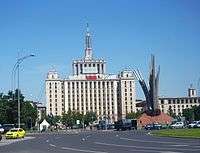
The communist Romanian People's Republic was established in 1947. Gheorghe Gheorghiu-Dej was premier of the Socialist Republic of Romania from 1947 until 1965. He began the country's policies of industrialization, with infrastructure development for heavy industry, and construction for mass resettlement to new industrial and agricultural centers away from Bucharest and other principal cities.
Prior to the mid-1970s, Bucharest, as most other cities, was developed by expanding the city, especially towards the south, east, and west. High density dormitory neighbourhoods were built at the outskirts of the city. Some, such as Drumul Taberei, Titan, and Giurgiului have architectural and/or urban planning value.
Systematization
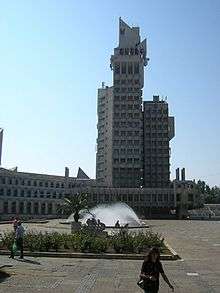

Nationalism, characterizing the last stage of Romanian communism, did not extend to contemporary Romanian architecture. Romanian Systematization was the program of urban planning carried out under the communist regime of Nicolae Ceauşescu (r. 1965–1989), after his 1971 visit to North Korea and China. It forced projects, designed with an architecture of pre-fab technology, that resulted in the construction of high density dormitory neighborhoods, with huge housing blocks of numerous eight to ten-story buildings housing flats, that leveled core district cityscapes. The fast urban growth respected neither traditional rural values nor a positive ethic of urbanism.
Traditional urban central areas and rural towns were destroyed in a process sarcastically dubbed Ceaușima. They were replaced by conglomerates of blocks of flats and industrial projects. His 'Food Complex' buildings (Circ al foamei), dubbed Hunger circuses, were identical large domed buildings intended as produce markets and food hypermarkets. Ceauşescu also imposed the erection of monumental public buildings, of a dull and eclectic classical solemnity.
The dominant example of the intrusion of Ceaușima egotism into the traditional urban fabric is the Centrul Civic (civic center) in the capital, with its grandiose and huge government palace built by Nicolae Ceauşescu, the 'Palace of the People' now post-revolution renamed the Palace of the Parliament. The civic district's construction necessitated the demolition of much of southern Bucharest beyond the Dâmboviţa River, with 18th and 19th century neighborhoods and their significant architectural masterpieces destroyed. The dominating government Palace is the world's largest civilian building with an administrative function, most expensive administrative building, and heaviest building. It and other edifices in the Centrul Civic are modern concrete buildings behind neoclassical quasi-fascist marble façades.
21st century


The Romanian Revolution of 1989 ousted Nicolae Ceauşescu and communist rule. The post-revolution Romanian culture has, in architecture and planning, been developing new concepts and plans for the country's needs of functionality and national aesthetics in an international context. Many modern 21st century buildings are mostly made of glass and steel. Another a trend is to add modern wings and façades to historic buildings (for example the Headquarters of the Union of Romanian Architects building).
Examples of post-communist architecture include: Bucharest Financial Plaza, Arena Națională, City Gate Towers, Bucharest Tower Center. Modern high rise residential buildings include the Asmita Gardens.
